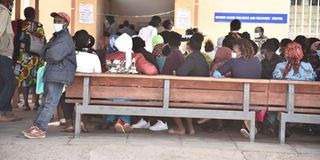Premium
Kericho, Bungoma to get new referral hospitals in UHC push

Patients at Nakuru Provincial General Hospital in this picture taken on February 2, 2021.The facility serves the larger South Rift region.
The South Rift region is set to benefit from a second teaching and referral hospital after the Cabinet approved the establishment of two new Level VI health facilities in Kericho and Bungoma counties.
According to a Cabinet dispatch released on Tuesday, the two facilities will be constructed in partnership with the African Development Bank.
Currently, the Nakuru Teaching and Referral Hospital is the largest such facility in the South Rift region.
It serves patients from Nakuru and more than six neighbouring counties, including Kericho, Nyandarua, Baringo, Narok, Laikipia and Samburu.
Victims of banditry from remote areas of Samburu, Baringo and Laikipia are often referred to the Nakuru hospital for specialsed treatment. The facility boasts an advanced cancer centre and the ultra-modern Margaret Kenyatta Mother and Baby Maternity wing, which has a 250-bed capacity.
Local leaders have proposed that the new hospital in Kericho County be constructed in Londiani town. The decision to build the hospitals is part of a broader initiative to improve healthcare infrastructure in counties that have historically struggled with access to advanced medical services.
According to the Cabinet, the two hospitals will help meet the growing demand for specialised treatment and expand access to quality healthcare services across the country. President Ruto, who chaired the Cabinet meeting said the initiative supports the government’s commitment to achieving UHC.
Kenya currently has more than eight national teaching and referral health facilities including Kenyatta National Hospital (KNH), Moi Teaching and Referral Hospital, Jaramogi Oginga Odinga Teaching and Referral Hospital, Nakuru Teaching and Referral Hospital, National Spinal Injury Hospital, Kisii Teaching and Referral Hospital, Mathari National Teaching and Referral Hospital and Kenyatta University Teaching and Referral Hospital.
Kenyatta National Hospital is the largest health facility in the country with a bed capacity of 1,800.
It was established under Legal Notice No 109 of April 6, 1987, and is mandated to receive patients referred from across Kenya and even neighbuoring countries for specialised healthcare. The hospital also trains medical students from various institutions including the University of Nairobi Medical School.
On average, KNH serves over 3,000 inpatients daily, records more than 70,000 admissions annually, treats about 2,500 outpatients daily and handles approximately 600,000 outpatient visits each year.
Mathari National Teaching and Referral Hospital is Kenya’s leading mental health facility. It was established in 1904 as a smallpox isolation center before being converted into a lunatic asylum.
In 1924, it was renamed Mathari Mental Hospital and later became Mathari Hospital in 1964. Today, it offers specialised psychiatric services, forensic services, drug rehabilitation, and mental health training for both public and private healthcare workers.
Earlier this month, Health Cabinet Secretary Aden Duale announced that at least 21.3 million Kenyans are now receiving free primary healthcare services at public and contracted private health facilities.
These services are available at all public Level 2 to 4 facilities, including dispensaries, health centers, and sub-county hospitals, as well as contracted faith-based and private institutions.
CS Duale also revealed that the government's new healthcare initiative under the Social Health Authority (SHA) has significantly improved upon the previous National Hospital Insurance Fund (NHIF). The expanded benefits package now includes services such as ICU care, cancer treatment, surgeries, and maternity services, which were not widely covered before.
President Ruto has consistently reiterated his administration's commitment to achieving UHC, expressing confidence in the SHA programme, which was launched last year.
“It is the biggest programme we have in the country. It may take time for things to align, but believe you me it is going to work,” the President said.


